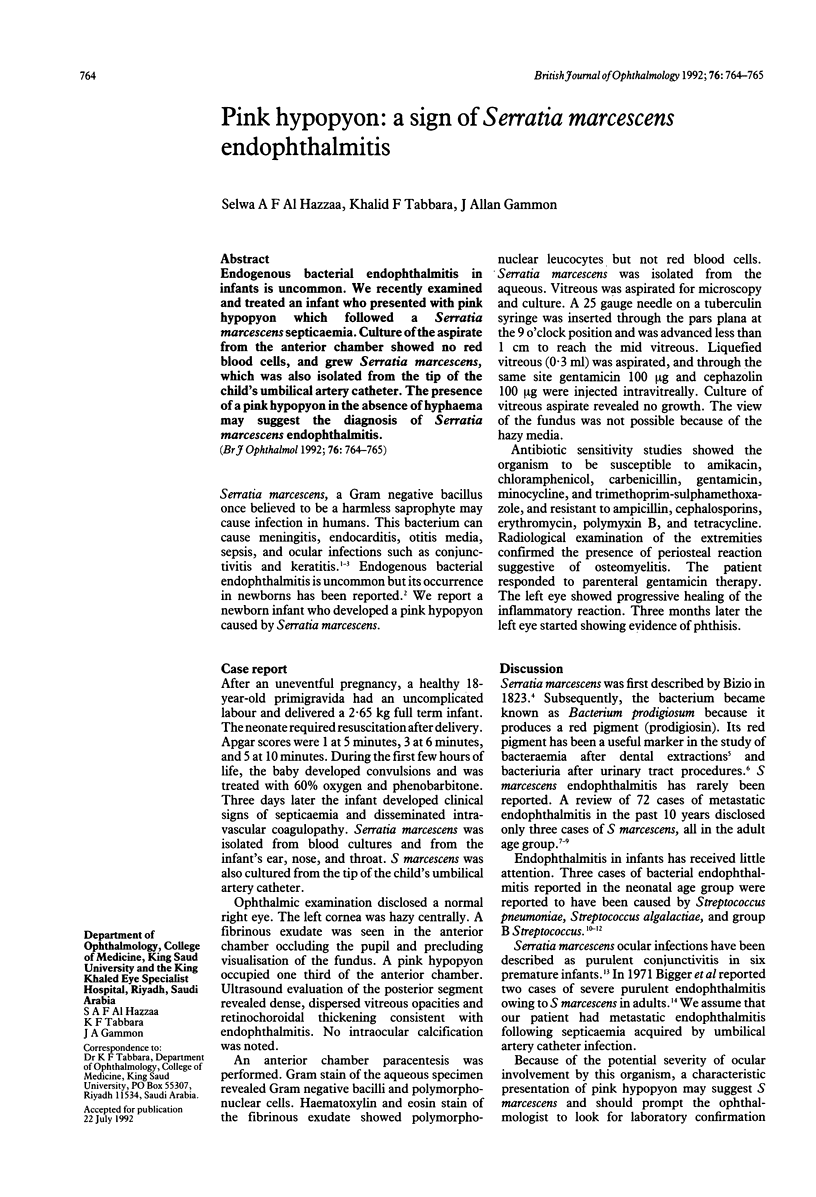Abstract
Endogenous bacterial endophthalmitis in infants is uncommon. We recently examined and treated an infant who presented with pink hypopyon which followed a Serratia marcescens septicaemia. Culture of the aspirate from the anterior chamber showed no red blood cells, and grew Serratia marcescens, which was also isolated from the tip of the child's umbilical artery catheter. The presence of a pink hypopyon in the absence of hyphaema may suggest the diagnosis of Serratia marcescens endophthalmitis.
Full text
PDF

Selected References
These references are in PubMed. This may not be the complete list of references from this article.
- Berger B. B. Endophthalmitis complicating neonatal group B streptococcal septicemia. Am J Ophthalmol. 1981 Nov;92(5):681–684. doi: 10.1016/s0002-9394(14)74661-6. [DOI] [PubMed] [Google Scholar]
- Bigger J. F., Meltzer G., Mandell A., Burde R. M. Serratia marcescens endophthalmitis. Am J Ophthalmol. 1971 Dec;72(6):1102–1105. doi: 10.1016/0002-9394(71)91216-5. [DOI] [PubMed] [Google Scholar]
- Davis J. T., Foltz E., Blakemore W. S. Serratia marcescens. A pathogen of increasing clinical importance. JAMA. 1970 Dec 21;214(12):2190–2192. doi: 10.1001/jama.214.12.2190. [DOI] [PubMed] [Google Scholar]
- Gammon J. A., Schwab I., Joseph P. Gentamicin-resistant Serratia marcescens endophthalmitis. Arch Ophthalmol. 1980 Jul;98(7):1221–1223. doi: 10.1001/archopht.1980.01020040073007. [DOI] [PubMed] [Google Scholar]
- Gaughran E. R. From superstition to science: the history of a bacterium. Trans N Y Acad Sci. 1969 Jan;31(1):3–24. doi: 10.1111/j.2164-0947.1969.tb02887.x. [DOI] [PubMed] [Google Scholar]
- Greene G. R., Carroll W. L., Morozumi P. A., Ching F. C. Endophthalmitis associated with group-B streptococcal meningitis in an infant. Am J Dis Child. 1979 Jul;133(7):752–753. doi: 10.1001/archpedi.1979.02130070088021. [DOI] [PubMed] [Google Scholar]
- Greenwald M. J., Wohl L. G., Sell C. H. Metastatic bacterial endophthalmitis: a contemporary reappraisal. Surv Ophthalmol. 1986 Sep-Oct;31(2):81–101. doi: 10.1016/0039-6257(86)90076-7. [DOI] [PubMed] [Google Scholar]
- KASS E. H., SCHNEIDERMAN L. J. Entry of bacteria into the urinary tracts of patients with inlying catheters. N Engl J Med. 1957 Mar 21;256(12):556–557. doi: 10.1056/NEJM195703212561206. [DOI] [PubMed] [Google Scholar]
- Lazachek G. W., Boyle G. L., Schwartz A. L., Leopold I. H. Serratia marcescens, an ocular pathogen; new considerations. Arch Ophthalmol. 1971 Nov;86(5):599–603. doi: 10.1001/archopht.1971.01000010601020. [DOI] [PubMed] [Google Scholar]
- Malnou F. Métastase septique endoculaire par Serratia. Bull Soc Ophtalmol Fr. 1981 Oct;81(10):803–806. [PubMed] [Google Scholar]
- Radda T. M. Metastatic Serratia marcescens endophthalmitis. Ophthalmologica. 1982;185(2):65–68. doi: 10.1159/000309226. [DOI] [PubMed] [Google Scholar]
- Stenderup A., Faergeman O., Ingerslev M. Serratia marcescens infections in premature infants. Acta Pathol Microbiol Scand. 1966;68(1):157–160. doi: 10.1111/apm.1966.68.1.157. [DOI] [PubMed] [Google Scholar]
- Weintraub M. I., Otto R. N. Pneumococcal meningitis and endophthalmitis in a newborn. JAMA. 1972 Mar 27;219(13):1763–1764. doi: 10.1001/jama.219.13.1763. [DOI] [PubMed] [Google Scholar]


